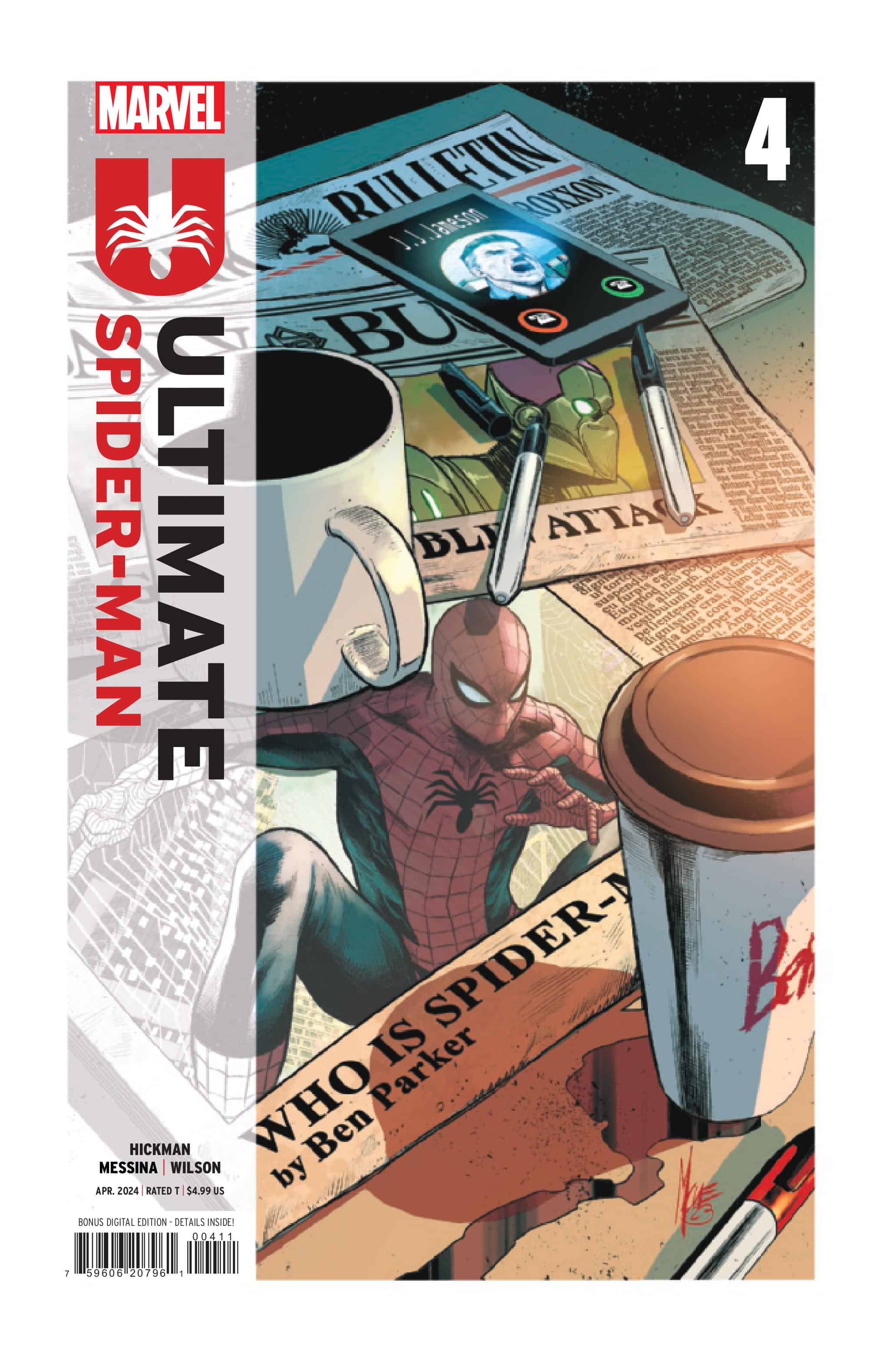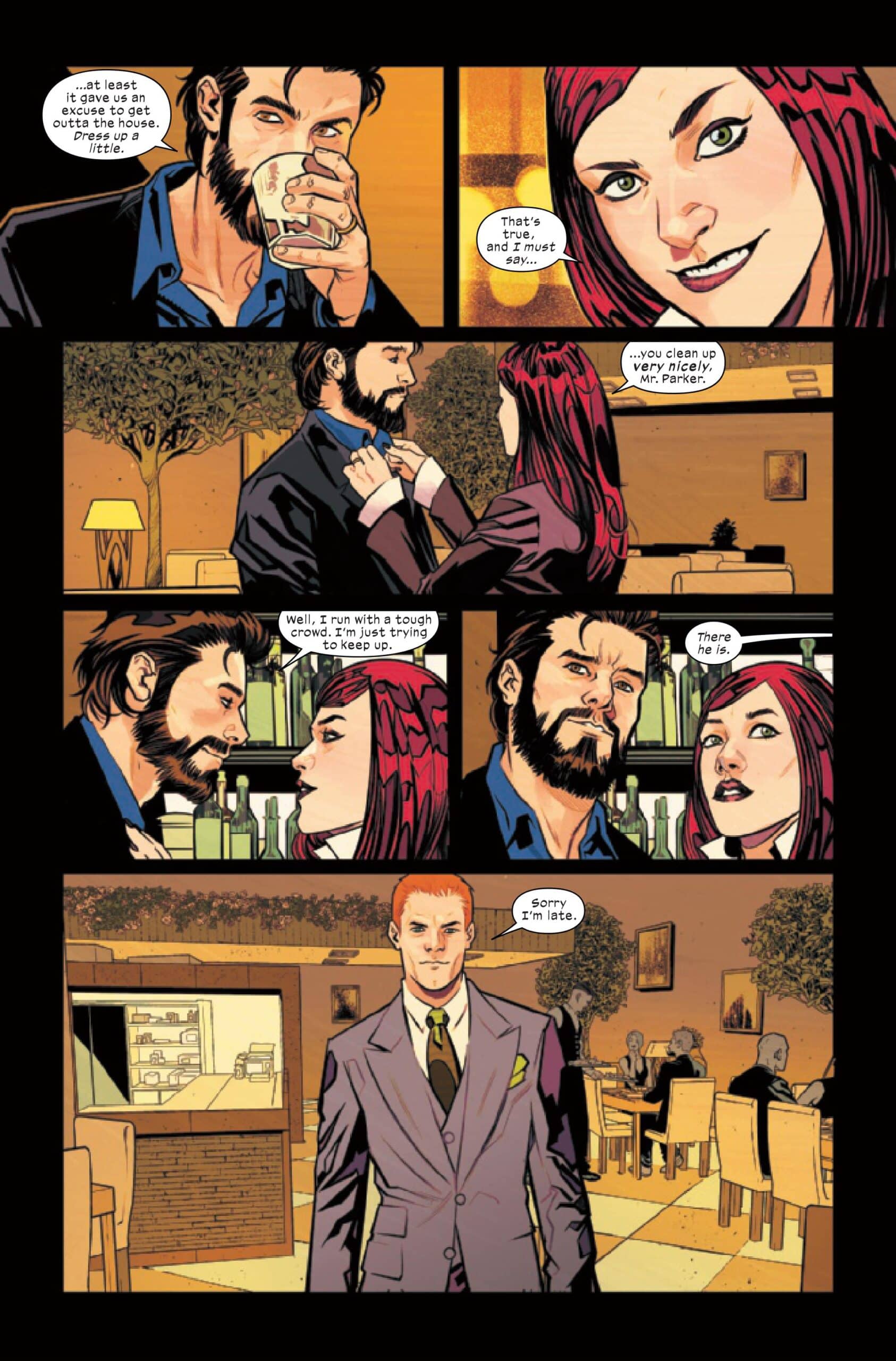Ultimate Spider-Man #4

Recap
WHO IS THE GREEN GOBLIN? Peter Parker's secret life starts fraying the edges of his personal life! J. Jonah Jameson and Ben Parker's pursuit of truth — or, at least, the news — stirs unrest with the world at large… And now that Spider-Man may not have to operate alone, the real work of rebuilding this corrupt world can begin!
Review
In his seminal autobiography and exploration of craft, Stephen King wrote “It’s dialogue that gives your cast their voices, and is crucial in defining their characters.” Dialogue is the backbone of good storytelling, especially in fiction built around the intersection and interaction around characters. It drives the narrative while establishing the characters as real humans that could exist in the world even if they’re imbued with the powers of a radioactive spider, from the future, or even a genius that dresses in a green mechanical suit.
Ultimate Spider-Man #4 – written by Jonathan Hickman with art by David Messina, colors by Matthew Wilson, and lettering from VC’s Cory Petit – trades swashbuckling action for an equally tense situation: a double dinner date. Peter and MJ break bread with Harry Osborn and his wife, Gwen Stacey, after the two vigilantes met face-to-face in the previous issue. While the adult Parkers are left fending for themselves at a nice restaurant, Uncle Ben and Jameson watch the younger members of the family. The children offer their brutally honest and colorful commentary on everything from Jameson’s entire personality and the duo’s fledging news venture.

Centered primarily around the dinner date, the tension and conflict flow as the Parkers and Osborns exchange barbs. Nothing in the dynamic is malicious with a genuine sense of curiosity shared between the four adults, but the tit-for-tat dialogue offers a window into the way this world exists and influences people. Mary Jane reveals her business finally, Harry lectures Peter on power and responsibility, and Gwen indicates the intense pressures and ambitions that come with her life. Each strand of the conversation moves the night along, to the point of interweaving the beats into two logical, restrained cliffhangers.
Hickman’s scripting for this issue is a masterclass in commanding interest without using a single beat of spandex or punches thrown. Instead, the compelling moments are a result of character and dialogue, which channels the best parts of the original Spider-Man. The writer of that series, Brian Michael Bendis, captures a very specific cadence and rhythm to his dialogue that feels organic and effortless to read. Here, Hickman takes the ethos and ages it up for these four adults, making clear that there’s a different spin to the scripting while still achieving a similar effect. The volley of passive aggression, brutal honesty, and zinging connections make the scripting for this issue an instant classic, illustrating the mature approach the book has offered since issue one.

The perfect collaborator for this issue is Messina, who delivers a style that is a bit more cartoony than regular artist Marco Checchetto. Checchetto thrives in all aspects of the comic page, blending realism and exaggerated reality into a beautiful tapestry of kinetic action. Contrasting it with Messina’s linework, which is much more simplified and expression-driven, the differences work to showcase just how different the circumstances are for this dinner. There’s an edge in certain moments of the extended conversation like Harry warning Peter about keeping secrets. Messina can turn from the fun, bouncy styling to a harsh moment of darkness that adds immediate weight to the scene.
Much of that differentiation on the page is a result of Wilson’s approach to the coloring for the issue, which trades in restrained colors for more vibrant backgrounds and simpler hues. Matching up with Messina’s streamlined lines, Wilson’s coloring explores the emotions and flow of the conversation much more than capturing the various sources of tones from the world. The issue picks up that coloring philosophy even in the gutters and page backgrounds, which offer lots of blacks to contrast the warm hues of the restaurant. Even as the Parkers and Osborns verbally spar back and forth, the book never loses its sense of majesty and innate beauty.

Raw, pure humanity exists in that sense of beauty, as Peter and MJ get to offer a united front, showcasing the best of their union throughout the issue. Peter is more confident throughout the story as a direct result of his seizing of destiny. Even with the enhanced physiology and confidence, Peter still needs encouragement and support from MJ, which is a touching beat that solidifies the beauty of this marriage. That beat also works to underscore how dangerous of fire Peter is playing with in not telling MJ about his powers, foreshadowing the last page reveal of the issue. Hickman’s dialogue keeps the plot moving while divulging more information about the various characters and the large world. MJ’s new business is unveiled to be a PR firm, ending the various speculations of the first three installments. The conversation with Gwen also reveals that MJ used to model as a wink to classic Spider-Man continuity.
The organic connection to this is MJ is working to help develop Ben and Jameson’s brand for their new business, which is currently slated to be The Paper. It’s a name that is so-so on the page but the rich dialogue sells it in MJ conversation. It also comes back later on, in the discussion between the newsmen and the Parker children. The kids have their various perspectives on the new venture, with the more touching one being between Richard and Ben. It hints at the maturity displayed by the older Parker child, showcasing the thoughtful streak in the well-read young man.

Moments of weaving between touching and ominous are a touchstone to Messina and Wilson’s approach to the page, and the clarity of emotions is never as well illustrated as on the final page. As MJ and Peter walk home and discuss the evening, Peter edges the conversation into vague territory about his secret life as Spider-Man, they are centered in each frame and often are conjoined in profile in wide moments.
It’s clear visual storytelling that signals they are on the same page, at least for now, and MJ is supportive of Peter and believes in him. In what could have been a moment drenched in doubt and possibilities, the artists instead reinforce the closeness and support these two share with one another. Even without Hickman’s crisp dialogue, it’s evident that these two are committed and in love, ready to face down the world together.
Final Thoughts
Commitment takes many forms in Ultimate Spider-Man #4, whether it be in the representations of the mirrored marriages of the Parkers and the Osborns, or the name of Ben and Jameson’s news organization. Even Peter’s commitment to the hero's life and notions of protecting his family are evident. Hickman makes these abundantly clear through well-crafted dialogue that evokes the muse of Brian Michael Bendis and his time on Ultimate Spider-Man, filtered through a more mature lens. The conversations depicted feel like a natural evolution from that series, trading the melodrama of high school for the more grounded realities of a well-worn life.
Working in tandem with Messina’s cleaner linework and Wilson’s simplified palette that trades the scratch stylings of Checchetto for a more character-driven aesthetic is a perfect fit for a story centered on dialogue. Ultimate Spider-Man #4 proves the series is a true successor to the original series while still delivering new, original ideas blended with the warm and comforting hallmarks of the character. There is no doubt this will be a celebrated run for nothing else than the trust and care embedded into the characterization and dialogue put to page.
Ultimate Spider-Man #4: My Dinner with the Osborns
- Writing - 10/1010/10
- Storyline - 10/1010/10
- Art - 10/1010/10
- Color - 10/1010/10
- Cover Art - 10/1010/10





